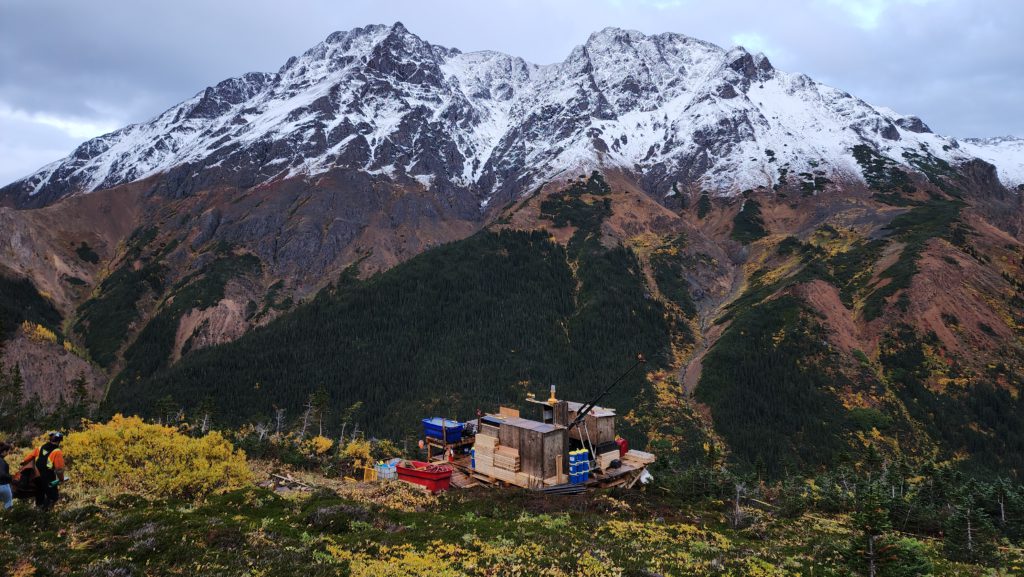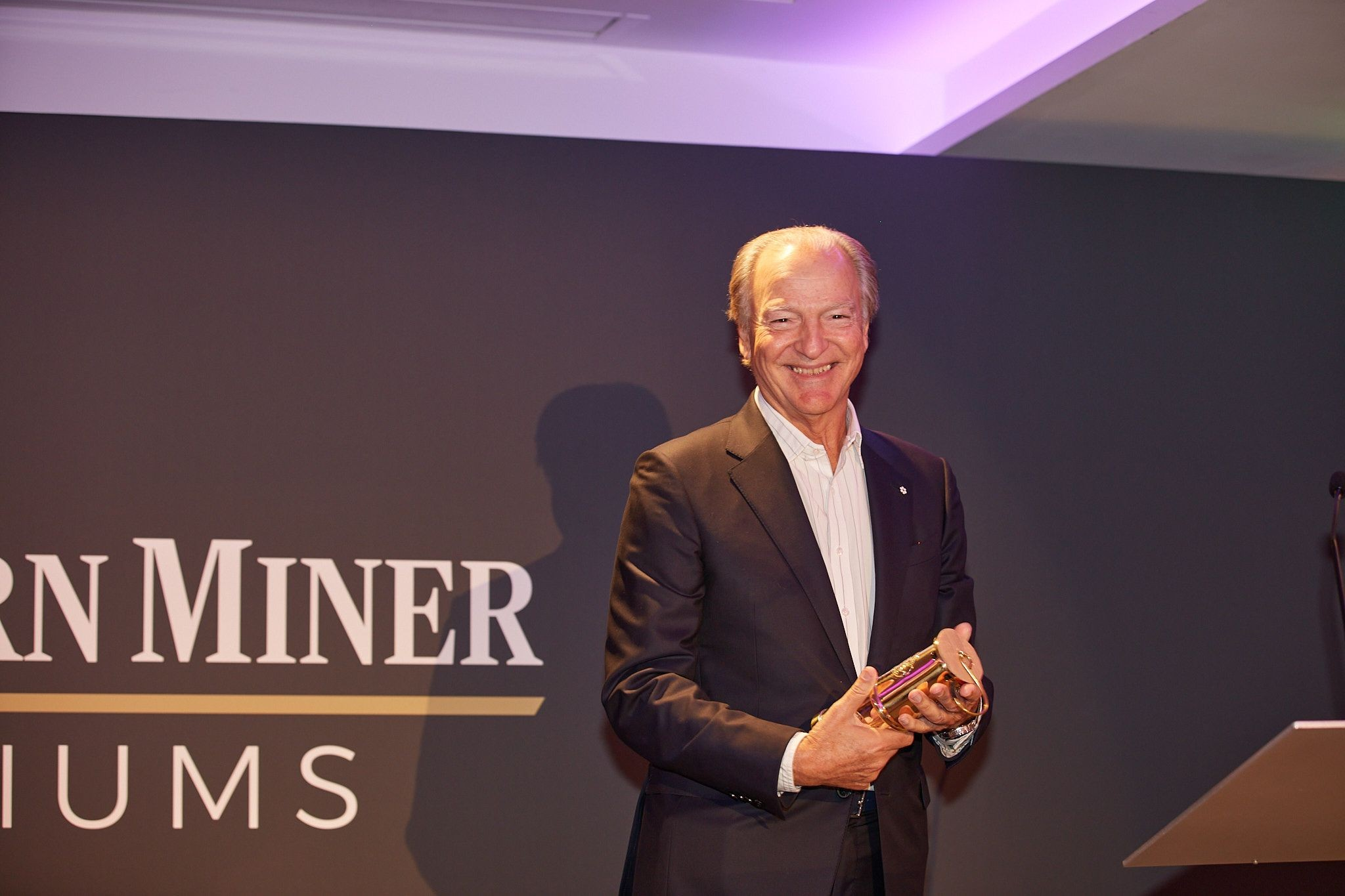The True North mine produced 2 million oz. gold over 100 years, including 36 years of continuous production from 1932 to 1968.
The project includes a permitted 1,300 tonne-per-day mill, camp and tailings facility, and is situated on the company’s 617-sq.-km Rice Lake property.
A resource estimate published late last year outlined 3.52 million indicated tonnes grading 4.41 grams gold per tonne and 5.49 million inferred tonnes grading 3.65 grams gold.
Since its drill program started in October, the company has completed at least 51 surface drill holes (11,695 metres) on targets within True North’s mine property footprint.
Highlights from the San Antonio West target include 1.4 metres grading 58.66 grams gold starting from 145 metres, including 0.9 metre of 63.20 grams gold in drill hole TN-25-057; 2.3 metres grading 9.59 grams gold from 103 metres, including 1.8 metres of 11.25 grams gold in TN-25-056; and 0.5 metre of 10.4 grams gold from 249 metres downhole in TN-25-058. Drill hole TN-25-037 cut 1 metre grading 8.73 grams gold from 61 metres downhole and 1 metre of 62.4 metres from 65 metres.
At San Antonio Southeast, a recently discovered near-mine target, drill hole TN-24-011 returned 0.84 metre of 8.37 grams gold from 278 metres downhole; and TN-24-014 cut 0.69 metre of 13.4 grams gold from 362 metres.
The company plans to mobilize drill rigs to key underground levels later this summer. In addition, it is exploring the past-producing Ogama-Rockland mine on its property, about 25 km east of True North. Ogama-Rockland produced about 45,000 oz. gold between 1948 and 1951.
1911 Gold has a market cap of about $45 million.
Banyan Gold
Banyan Gold (TSXV: BYN; US-OTC: BYAGF) raised $14.5 million in a non-brokered private placement in March and launched a fully funded 30,000-metre drill program at its AurMac project in the Yukon, 356 km north of Whitehorse.
The 2025 drill program will follow up on high-grade intersections from last year, such as 15.9 metres grading 9.32 grams gold starting from 65.7 metres in drill hole AX-24-590, including 3.7 metres of 33.43 grams gold at the Airstrip deposit; and 23.1 metres of 5.68 grams gold from 159.3 metres, including 0.2 metre of 539.3 grams gold in drill hole AX-24-540 at the Powerline deposit.
Banyan also plans surface sampling, metallurgical work and environmental surveys this year, and intends to complete a preliminary economic assessment of the AurMac project in the fourth quarter.
The company completed an inferred resource estimate for the project’s Airstrip and Powerline deposits in February 2024, outlining 347.5 million tonnes grading 0.63 gram gold. The deposits remain open at depth.
The 215 sq.-km land package at AurMac is transected by the main Yukon highway and benefits from a three-phase powerline and power station.
In addition to AurMac, Banyan Gold holds the 227-sq.-km grassroots Nitra gold project, about 10 km west of AurMac, and the 125-sq.-km Hyland gold project, about 70 km northeast of Watson Lake, along the southeast end of the Tintina Gold Belt.
Banyan Gold has a market cap of about $87 million.
Brixton Metals
Brixton Metals’ (TSXV: BBB; US-OTC: BBBXF) flagship Thorn copper-gold-silver-molybdenum project encompasses one of the largest porphyry copper-gold geochemical anomalies in B.C.
The 2,945-sq.-km project, 40 km from tidewater and about 90 km northeast of Juneau, Alaska, has more than 20 large exploration targets and BHP (NYSE, LSE, ASX: BHP) holds a strategic 19.9% stake in the company.
Highlights from drilling the project’s Camp Creek copper porphyry target last year are 114.5 metres grading 0.53 gram gold and 20.1 grams silver in hole THN24-307, including 26 metres at 1.89 grams gold, 74.8 grams silver and 0.28% copper. Hole THN24-294 cut 124 metres at 0.29% copper, 0.07 gram gold, 2.6 grams silver and 134 parts per million (ppm) molybdenum.
At the Trapper gold target, drill hole THN24-304 cut 8 metres of 11.37 grams gold per tonne, including 2 metres of 44.43 grams gold; and drill hole THN22-205 intersected 64 metres grading 5.74 grams gold, including 28.95 metres of 10.36 grams gold.
The company’s 2025 drill season got underway in May. The fully funded program involves drilling 8,000 to 10,000 metres to expand near-surface gold mineralization and drill test new copper porphyry targets. The program will be split equally between gold and copper targets at the project.
This year’s work program will also drill test two new copper porphyry targets — Catalyst and Tempest — about 6-8 km northeast of the Camp Creek porphyry. Rock grab samples from Catalyst returned up to 0.56% copper, 2.87 grams gold and 30 grams silver. The showing is within a broader 1.6-km by 1-km northeast trending phyllic to argillic alteration zone and remains open.
Brixton Metals has a market cap of about $32 million.
Core Nickel
Core Nickel (TSXV: CNC) is exploring five nickel projects on its 270-sq.-km contiguous land package in the Thompson Nickel Belt of northern Manitoba, about 20 km north of the city of Thompson.
Its main project, the Mel deposit, lies 25 km from Vale’s (NYSE: VALE) operating Thompson mill complex. The results from re-assays of core from 12 historic drill holes at Mel were reported in April, with highlights of 5.8 metres grading 2.92% nickel starting 84.8 metres downhole in DDH-102501; 10.2 metres at 2.42% nickel in DDH-89296 from 83.5 metres depth; 11.7 metres grading 2.81% nickel from 83.4 metres in DDH-89300 and 36.3 metres at 1.73% nickel from 93.8 metres in DDH-102503.
The Mel deposit has a historical resource of 4.28 million indicated tons (3.88 million tonnes) grading 0.88% nickel for 82.5 million contained lb. and another 1.01 million inferred tons at 0.84% nickel for 18.67 million pounds.
The near-surface deposit was discovered in the 1960s at a depth of 50 metres, and historic drilling over the last 50 years has focused on shallow depths averaging 200 metres. By comparison, Vale’s Thompson nickel mine operates at depths of more than 1,000 metres.
At its Halfway Lake project, 12 km northwest of Waboden, highlights from last year’s drill program included 91 metres grading 0.37% nickel from a depth of 120 metres in the W62 Zone.
This year’s 3,586-metre drill program wrapped up in April. It focused on testing high-priority targets identified in a VTEM (versatile time domain electromagnetic) survey last year. The program intersected a new near-surface, pyrrhotite-rich massive sulphide zone open along strike and at depth, as well as a new zone with Pipe Formation stratigraphy in the southern area, where the company says the structural and geological features resemble those of the Thompson deposit
Halfway Lake is situated about 15 km from CaNickel Mining’s (TSXV: CML) past-producing Bucko mill, and 90 km from Vale’s operating Thompson mill.
Core Nickel has a market cap of about $6 million.




